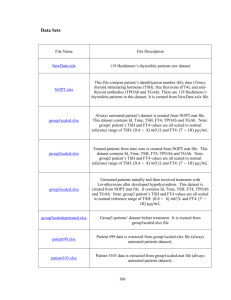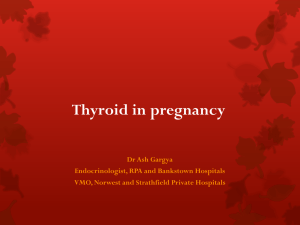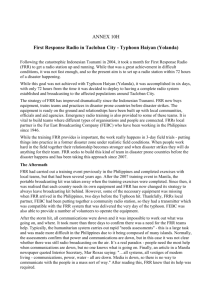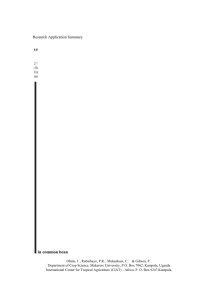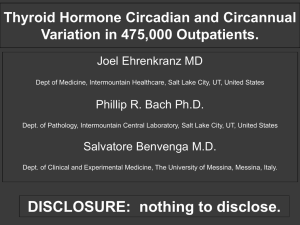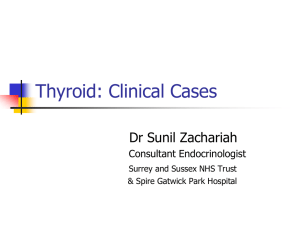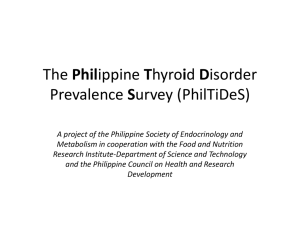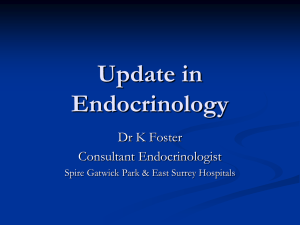A system-biology approach
advertisement
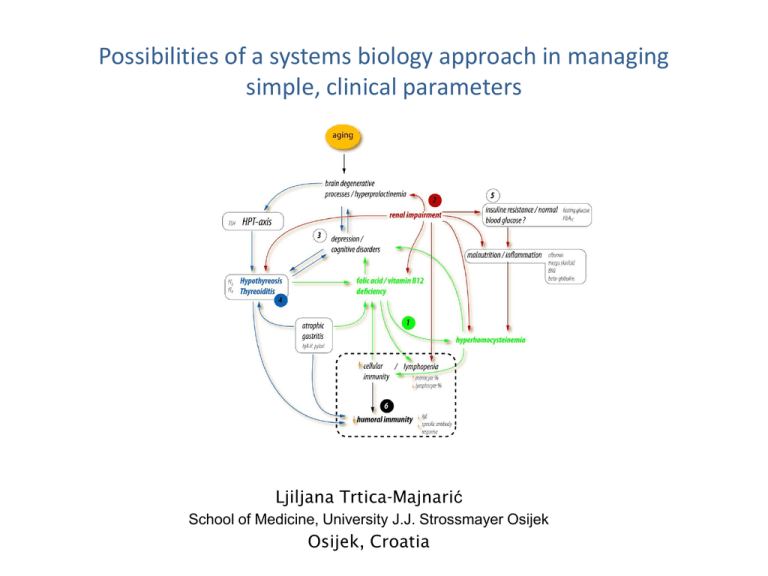
Possibilities of a systems biology approach in managing simple, clinical parameters Ljiljana Trtica-Majnarić School of Medicine, University J.J. Strossmayer Osijek Osijek, Croatia • A complex problem-solving task analysis, in the area of preventive medicine • A case study - low antibody response to influenza vaccination A research question • How to identify subjects who are likely to poorly respond to influenza vaccine? (trivalent, inactivated, annually applied vaccine, for elderly (≥65 y) and chronically ill patients) Important • For planning influenza vaccination protocol (new vaccines and vaccination approaches available) Background Influenza vaccine efficacy is significantly lower in the elderly than in younger population groups Proposed factors mutually interdependent Older age (≥ 65 years) Chronic diseases (health parameters) a major difficulty for modelling A methodology approach Models of prediction Influenza viruses different vaccine status and differences in past infections A new research question How to identify health parameters suitable for general use (in models of prediction)? A complex problem-solving approach Limited theoretical background (unknown immunoregulatory mechanisms) A wide range of poorly identified health factors (stages of a disease, co-morbidity, biochemical disorders, lifestyles) A methodology approach? A reductionist approach A system-biology approach • Only recognised, directly relevant variables are used • Strongly hypothesis-driven • • • • All (almost all) components of the system are considered Hypothesis-free Research protocol Computationally intensive - the use of advanced techniques A systems biology/Machine Learning Originally applied in the emerging field of metabolomics (genomics, proteomics...) A whole cell / tissue content analysis A study of pathways and networks in biological systems A systems biology approach systematic data recording / a multi-step research protocol / predictive modelling Theory Definition of a research question Searching through published papers for basic information Data Mining modelling Data collection Definite, statistically significant validation Building models of prediction Computation based on using Machine Learning techniques A visual model of the biological network A dataset The sample Laboratory tests indicating • • • • • • • Inflammation Nutritional status Metabolic status Chronic renal impairment Latent chr. infections Humoral immunity Neuroendocrine status 93 (35M, 58 F) 50-89 y (M 69) Performed laboratory tests • Inflammation: WBC* count, WBC differential (% neutrophils, lymphocytes, eosinophils, and monocytes), CRP, and serum proteins electrophoresis (a1, a2, b, g-globulins) • Nutritional status: RBC count, haemoglobin, MCV, iron, serum albumin, folic acid, vitamin B12, and homocysteine • Metabolic status: fasting glucose, HbA1c, total cholesterol, HDLcholesterol and triglycerides • Chronic renal impairment: Creatinine clearance • Latent infections: Helicobacter pylori specific IgA and IgG and cytomegalovirus specific IgG • Humoral immunity: IgE and ANA • Neuroendocrine status: Blood cortisol in the morning, TSH, fT3, fT4, and prolactin *Abbreviations WBC (white blood cell); CRP (C-reactive protein); RBC (red blood cell); MCV ( mean cell volume); HbA1c (glycosilated haemoglobin); HDL (high-density lipoprotein); ANA (antinuclear antibodies); TSH ( thyroid-stimulating hormone); fT3 (free triiodothyronine); fT4 (free thyroxine) Data mining - finding patterns in the data Attribute ranking Attribute Cut-off value Statistically significant properties Sensitivity % Specificity % > 8,0 (%) ≤ 212,0 (pmol/L) 90,0 80,0 70,8 75,0 homocysteine fT4 Creatinine cl. * >12,7 (mol/L) ≤13,65 (pmol/L) ≤1,55 (ml/s/1.73m2) 80,0 70,0 70,0 75,0 79,1 75,0 6. skinfold thickness ≥ 32,50 (mm) 80,0 62,5 Model No. 2 1. 2. 3. 4. 5. 6. Model No. 3 Monocyte % g-globulins MCV H.pylori IgA prolactin b-globulins > 7,85 (%) >13,05 (g/L) >90,50 (fl) >11,80 (IU/ml) >90,24 (mIU/L) >8,50 (g/L) 71,4 64,2 78,5 78,5 85,7 64,2 73,6 78,9 63,1 63,1 57,8 73,6 1. 2. 3. 4. 5. Lymphocyte % fT4 Fasting glucose b-globulins Monocyte % ≤ 35,10 (%) ≤13,65 (pm/L) ≤5,45 (mol/L) ≥8,05 (g/L) >7,95 (%) 65,6 59,3 50,0 53,1 65,6 63,6 68,1 77,2 72,7 56,8 6. Model No. 4 1. 2. 3. Serum albumin <45,35 (g/L) 75,0 54,54 Lymphocyte % Monocyte % Skinfold thickness ≤ 35,40 (%) >7,95 (%) ≤ 34,50 (mm) 56,7 59,7 65,6 89,4 84,2 73,6 4. 5. 6. fT4 age TSH ≤ 14,5 (pmol/L) > 65,5 (years) >1,39 (UI/ml) 71,6 71,6 59,7 63,1 63,1 68,4 Model No. 1 1. 2. Monocyte % vitamin B12 3. 4. 5. *Abbreviations: fT4 (free thyroxine), Creatinine cl. (Creatinine clearance), MCV (Mean Cell Volume), H. (Helicobacter) pylori, TSH (thyroid-stimulating hormone) Data mining - a pool of 16 selected parameters Data Mining models. Model No. 1 Model No. 2 Model No. 3 Model No. 4 Parameters selected in a particular model Parameters overlapping in 2 or more models CLINICAL CONDITIONS INTERMEDIATE MECHANISMS Creatinine clearance, Homocysteine Monocyte %, Vitamin B12, fT4, Triceps skinfold thickness H. pylori IgA*, g-globulins, Monocyte %, MCV [indicating vitamin B12], b-globulins Prolactin Fasting glucose, Serum albumin Monocyte %, Lymphocyte %, fT4, b-globulins Age, TSH Monocyte %, Lymphocyte %, fT4, Triceps skinfold thickness *Abbreviations: H. (Helicobacter) pylori, fT4 (free thyroxine), MCV (Mean Cell Volume), TSH (thyroid-stimulating hormone) Four LR models By varying criteria for definition of the model`s outcome measure (7 health parameters used) Attribute ranking Model No. 1 1. 2. 3. 4. 5. 6. Attribute Estimated parameter p-value AGE KONG_1 VACC (0) H1N1_1 VACC (1) SICM_1 0.0526 0.0843 1.8036 -0.0241 2.0287 -0.0133 0.0013 0.0117 0.0575 0.0721 0.0382 0.0976 Model quality: Likelihood ratio = 42.428 [p=0.0001]; c = 0.863 ; Somers’ D = 0.725; AIC = 128.142 Model No.2 1. HOMCYS 0.1922 2. FT4 -0.1790 3. H1N1_1 0.0472 4. VACC (1) 1.1912 5. VACC (2) 1.4516 0.0132 0.0992 0.0892 0.0871 0.0633 Model quality: Likelihood ratio = 20.022 [p=0.0012]; c = 0.764 ; Somers’ D = 0.528; AIC = 124.156 Model No. 3 1. HPA -0.0375 2. FT4 -0.6004 3. VITB12 -0.00632 4. GAMA 0.5176 0.0268 0.0314 0.0708 0.0646 Model quality: Likelihood ratio = 20.945 [p=0.0003]; c = 0.897 ; Somers’ D = 0.794; AIC = 51.961 Model No. 4 1. LY 0.0759 2. VACC (1) -1.7413 3. VITB12 0.00301 4. SICM_1 -0.0300 5. FT4 0.2290 0.0053 0.0118 0.0095 0.0400 0.0687 Model quality: Likelihood ratio =30.759 [p=0.0001]; c = 0.834 ; Somers’ D = 0.669; AIC = 123.263 Subsequent data mining transforming selected parameters into disorders Constructing a visual model of the biological network, supported by expert knowledge A series of cognitive patterns A visual model of the biological network Benefits Clinical conditions, relationships and mechanisms mapped within a large, poorly recognised input space Selected health parameters placed into clinical context Improved understanding A decision-making support tool A starting position for research A systems biology - a study of pathways and networks An ongoing computer-based research protocol A complex problem-solving approach, in the situated, real life scenario A need for developing a conceptual framework to promoting a complex problem-solving oriented research research agenda should determine research methods ... ... opposite to what is nowadays, when the clinical projects are to meet the criteria for the classical research design based on using reductionist methods a systems biology approach, based on intensive computerisation, seems promising a partnership between a computer programmer & an expert Challenges for SB in planning preventive strategies for chronic aging diseases • • • Preventive strategies could be improved and economically justified if relied on the possibility of identifying factors responsible for prediction of the outcomes and/or definition of the target groups For many preventive tasks, risk and prediction factors have not yet been identified It is not possible to select subjects into the target groups according to the diagnosis of a disease, but rather on using multiple factors... Due to the characteristics of chronic aging diseases - gradually changing continuum from health to a disease frequent subclinical disorders overlapping in genetic and environmental risk factors shared clinical expression among related disorders Consequences at the clinical level - several diseases and disorders occure in one person the great interindividual diversity (including the number, combination and stages of disorders) heterogeneity of the studied groups Possibilities of a SB as a multidimensional analytical method • The first step knowledge discovery, for a computer-based problem simulation Preferences • General conclusions drawn from small samples • A larger spectrum of research questions are getting a chance of being solved (for problems lacking in evidence, complex real life problems) • Introductory to research in chronic aging diseases and co-morbidity • More specific identification of the target groups - an improvement beyond the traditional screening methods • Information from other sources (on family history, socio-economic status, local environment, occupation, specific genetic traits or biomedical markers, genomics) can be added to the basic health dataset - various comprehensive conclusions, based on modelling • Contribution to the preventive health programs implementation More specific identification of the target groups A state of equilibrium - a possibility to replace molecular biology markers with biochemical and clinical parameters Shared parameters for predicting the most common chronic aging diseases A cellular homeostasis Apoptosis and a cell cycle A cellular homeostasis Apoptosis and a cell cycle Possibilities of a SB in CV risk prediction • Risk charts and scores have been developed to assess the risk for CV events • The major risk factors were identified a long time ago, but evidence indicates the need for adding new risk factors into revised scores - DM, pre-diabetes and metabolic sy states, hyperhomocysteinemia, chronic renal impairment, latent infections (CMV, HP), complex socioeconomic factors • Up to 1/3 of the first coronary events occur among individuals without conventional risk factors • Experiences gained so far in the early detection of DM type 2 - the risk assessment depends on the characteristics of the studied population; it is not possible to develop an uniform, generally applicable risk assessment tool - Different distribution of risk factors in respective populations, the same risk factors have not the same effect in determing diseases - Changes in trends over time, accumulation of new knowledge • A need for a more dynamic and adaptable framework for preparing effective risk scores - a systems biology approach seems promising CV risk score High risk versus low risk population groups Possibilities of a systems biology aproach in managing simple, clinical parameters • A decisin-making relies on multiple factors, some of which still unidentified • A solution depends on complex, situated, a real life scenario • A systems biology methodology may prove useful • A tendency for using simpler, cheaper, widely available parameters • In family medicine, an electronic health record provides the opportunity for data collection and integration by using advanced computer-based techniques
